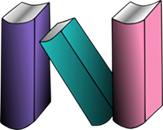 JohnMédiateur
JohnMédiateur
http://www.distance-education.org/Articles/Schools-are-Switching-Textbooks-for-iPads--Good-for-Education-or-Unnecessary-Expense--511.htmlApproximately 600 school districts have transitioned from traditional textbooks to the iPad—and the change may soon be coming to college campuses. Proponents of the iPad in schools claim a range of benefits—from lowered costs to less strain on students’ backs. But is the iPad really a good replacement for a textbook? Here’s a look at the pros and cons.
The iPad Advantage
They’re more portable
The issue with strain on students’ backs isn’t a joke. Students of all ages are used to carrying heavy books in a bulging backpack—and with the iPad, taking books and notebooks to class won’t be as onerous. For young students, it’ll be a relief not to have to carry a heavy backpack to class.
You don’t have to charge an iPad during the day
Student with iPad
While a few primary and secondary school districts have made a transition to the iPad, the device is still not ubiquitous on college campuses.
When comparing the iPad to a laptop, battery life offers a clear advantage for iPad users. Students relying on iPads don’t need to worry about bringing a power cord or finding an outlet to make sure the device will work throughout the day—as long as they remember to plug it in at night.
Access to a wide range of learning resources
Where the iPad really excels is in its role as a device for information consumption. Instead of simply reading a textbook, students can take in the e-textbook, online libraries and resources, news sites, and more—all with an easy click. The iPad streamlines research projects and, according to many, enriches learning because of the easy availability of online resources integrated with the e-textbook.
More room in schools
With iPads for every student, schools won’t have to maintain distinct computer labs—freeing up space in many crowded schools. However, it should be pointed out that iPads work much better as personal devices than as shared—and there are logistical, privacy, and software difficulties with sharing iPads between students during the school year.
It makes students more computer-literate
In today’s economy, fluency with the Internet and digital devices is extremely helpful. Proponents of iPads in classrooms claim that the devices make students more technically literate and prepare them better for a world that relies on technology.
Drawbacks of iPads in a Classroom Setting
Cost
Some administrators and iPad supporters claim that the iPad will be cheaper—for both school districts and students. But iPads by themselves are not cheap. They retail at approximately $500, and while school districts can often secure a discount through Apple, they’re still in the three figures. In primary and secondary schools, some parents can’t afford the cost of the tablets up front—it’s likely this change will only be practical in high-income school districts.
For college students used to spending hundreds or even thousands of dollars per year on textbooks, the iPad may actually be cheaper. A typical textbook on the iPad costs about $14.99—meaning that after you shell out for the cost of the iPad itself, your college textbook costs may drop significantly.
There’s a learning curve
There’s a tendency among administrators and educators to believe that young people in particular are “digital natives” who will naturally take to new technologies. This isn’t always the case—the new technology, and particularly the touch interface, will require some amount of time to get accustomed to. Adding the task of learning to use a new device with all the other requirements of college may be an added burden for some students, at least at first.
It’s difficult to type on an iPad
The iPad’s touch-screen type interface is not generally considered easier to type on than a computer keyboard. If you’re taking short, annotated notes, it’s doable—parituclarly for students who are very accustomed to the interface. But for longer note-taking sessions or for writing papers, it’s often impractical. It’s not likely the iPad is ready to replace a laptop or even a spiral-bound notebook in this respect.
The availability of textbooks is still small
At present writing, it’s still not easy to find a wide range of textbooks in e-format. Many teachers who use iPads now use a hodgepodge of content including web-based materials, digital documents, and information from the textbooks that are available. However, it’s generally believed that digital textbooks will soon be common and easy to access—and this is likely to increase along with the demand.
While a few primary and secondary school districts have made a transition to the iPad, the device is still not ubiquitous on college campuses. However, that may change—especially if administrators can find ways to cut costs by using the iPad. The technology has the potential to make some things easier in the classroom—but educators should also be aware of its limits.
The iPad Advantage
They’re more portable
The issue with strain on students’ backs isn’t a joke. Students of all ages are used to carrying heavy books in a bulging backpack—and with the iPad, taking books and notebooks to class won’t be as onerous. For young students, it’ll be a relief not to have to carry a heavy backpack to class.
You don’t have to charge an iPad during the day
Student with iPad
While a few primary and secondary school districts have made a transition to the iPad, the device is still not ubiquitous on college campuses.
When comparing the iPad to a laptop, battery life offers a clear advantage for iPad users. Students relying on iPads don’t need to worry about bringing a power cord or finding an outlet to make sure the device will work throughout the day—as long as they remember to plug it in at night.
Access to a wide range of learning resources
Where the iPad really excels is in its role as a device for information consumption. Instead of simply reading a textbook, students can take in the e-textbook, online libraries and resources, news sites, and more—all with an easy click. The iPad streamlines research projects and, according to many, enriches learning because of the easy availability of online resources integrated with the e-textbook.
More room in schools
With iPads for every student, schools won’t have to maintain distinct computer labs—freeing up space in many crowded schools. However, it should be pointed out that iPads work much better as personal devices than as shared—and there are logistical, privacy, and software difficulties with sharing iPads between students during the school year.
It makes students more computer-literate
In today’s economy, fluency with the Internet and digital devices is extremely helpful. Proponents of iPads in classrooms claim that the devices make students more technically literate and prepare them better for a world that relies on technology.
Drawbacks of iPads in a Classroom Setting
Cost
Some administrators and iPad supporters claim that the iPad will be cheaper—for both school districts and students. But iPads by themselves are not cheap. They retail at approximately $500, and while school districts can often secure a discount through Apple, they’re still in the three figures. In primary and secondary schools, some parents can’t afford the cost of the tablets up front—it’s likely this change will only be practical in high-income school districts.
For college students used to spending hundreds or even thousands of dollars per year on textbooks, the iPad may actually be cheaper. A typical textbook on the iPad costs about $14.99—meaning that after you shell out for the cost of the iPad itself, your college textbook costs may drop significantly.
There’s a learning curve
There’s a tendency among administrators and educators to believe that young people in particular are “digital natives” who will naturally take to new technologies. This isn’t always the case—the new technology, and particularly the touch interface, will require some amount of time to get accustomed to. Adding the task of learning to use a new device with all the other requirements of college may be an added burden for some students, at least at first.
It’s difficult to type on an iPad
The iPad’s touch-screen type interface is not generally considered easier to type on than a computer keyboard. If you’re taking short, annotated notes, it’s doable—parituclarly for students who are very accustomed to the interface. But for longer note-taking sessions or for writing papers, it’s often impractical. It’s not likely the iPad is ready to replace a laptop or even a spiral-bound notebook in this respect.
The availability of textbooks is still small
At present writing, it’s still not easy to find a wide range of textbooks in e-format. Many teachers who use iPads now use a hodgepodge of content including web-based materials, digital documents, and information from the textbooks that are available. However, it’s generally believed that digital textbooks will soon be common and easy to access—and this is likely to increase along with the demand.
While a few primary and secondary school districts have made a transition to the iPad, the device is still not ubiquitous on college campuses. However, that may change—especially if administrators can find ways to cut costs by using the iPad. The technology has the potential to make some things easier in the classroom—but educators should also be aware of its limits.
_________________
En achetant des articles au lien ci-dessous, vous nous aidez, sans frais, à gérer le forum. Merci !
"Qui a construit Thèbes aux sept portes ? Dans les livres, on donne les noms des Rois. Les Rois ont-ils traîné les blocs de pierre ? [...] Quand la Muraille de Chine fut terminée, Où allèrent ce soir-là les maçons ?" (Brecht)
"La nostalgie, c'est plus ce que c'était" (Simone Signoret)
 Blan6ineÉrudit
Blan6ineÉrudit
Moi, j'aimerais voir le service de maintenance mis en place... 

 InvitéStNiveau 6
InvitéStNiveau 6
https://www.youtube.com/watch?v=ouAdWPMOE4w&feature=related
 MelanieSLBDoyen
MelanieSLBDoyen
Quelle horreur! J'ai un i-pad, j'adore lire, mais je trouve que ce n'est pas pratique du tout de lire un livre dessus, alors un manuel scolaire  .
.
_________________
La réforme du collège en clair : www.reformeducollege.fr .
Et pour ceux qui voudraient en comprendre quelques fondements idéologiques:
De l’école, Jean-Claude Milner, visionnaire en 1984 (ça ne s'invente pas!) de ce qui nous arrive: "On ne dira pas que les enseignants sont l'appendice inutile d'une institution dangereuse et presque criminelle; on dira seulement qu'ils doivent devenir Autres: animateurs, éducateurs, grands frères, nourrices, etc. La liste est variable. Que, par là, les enseignants cessent d’être ce qu'ils doivent être, c'est encore une fois sortir de la question. On ne dira pas que les enseignants n'ont pas à exister, mais qu'ils ont à exister Autrement. Que cette Autre existence consiste à renoncer à soi-même pour disparaître dans la nuit éducative et s'y frotter, tous corps et tous esprits confondus, avec les partenaires de l'acte éducatif - manutentionnaires, parents, élèves, etc. -, seul un méchant pourrait en prendre ombrage." (page 24)
 MarcassinHabitué du forum
MarcassinHabitué du forum
Mais qui t'a dit qu'il s'agissait de lire quoi que ce soit ?
_________________
"Je regarde la grammaire comme la première partie de l'art de penser." (Condillac)
- Publication du logiciel libre GemaSCO (gestion manuels scolaires) version 3.0
- NRP : je suis abonnée version papier et j'aurais besoin d'accéder au numéro 52 en ligne.
- Connaissez-vous des établissements qui seraient revenus aux manuels papier après le numérique ?
- manuels hatier 4è et 3è version 1997
- Livraison des nouveaux manuels, version 2016
Permission de ce forum:
Vous ne pouvez pas répondre aux sujets dans ce forum




